Beef bone broth has become a genuine phenomenon in the world of nutrition and home cooking, and for good reason. This golden liquid is packed with essential nutrients that our ancestors knew well but that we’ve somewhat forgotten with the advent of industrial broths. Today, I’m sharing my proven method for preparing homemade beef bone broth recipe that surpasses anything you could buy in stores.
Table of Contents
Why Make Your Own Beef Bone Broth?
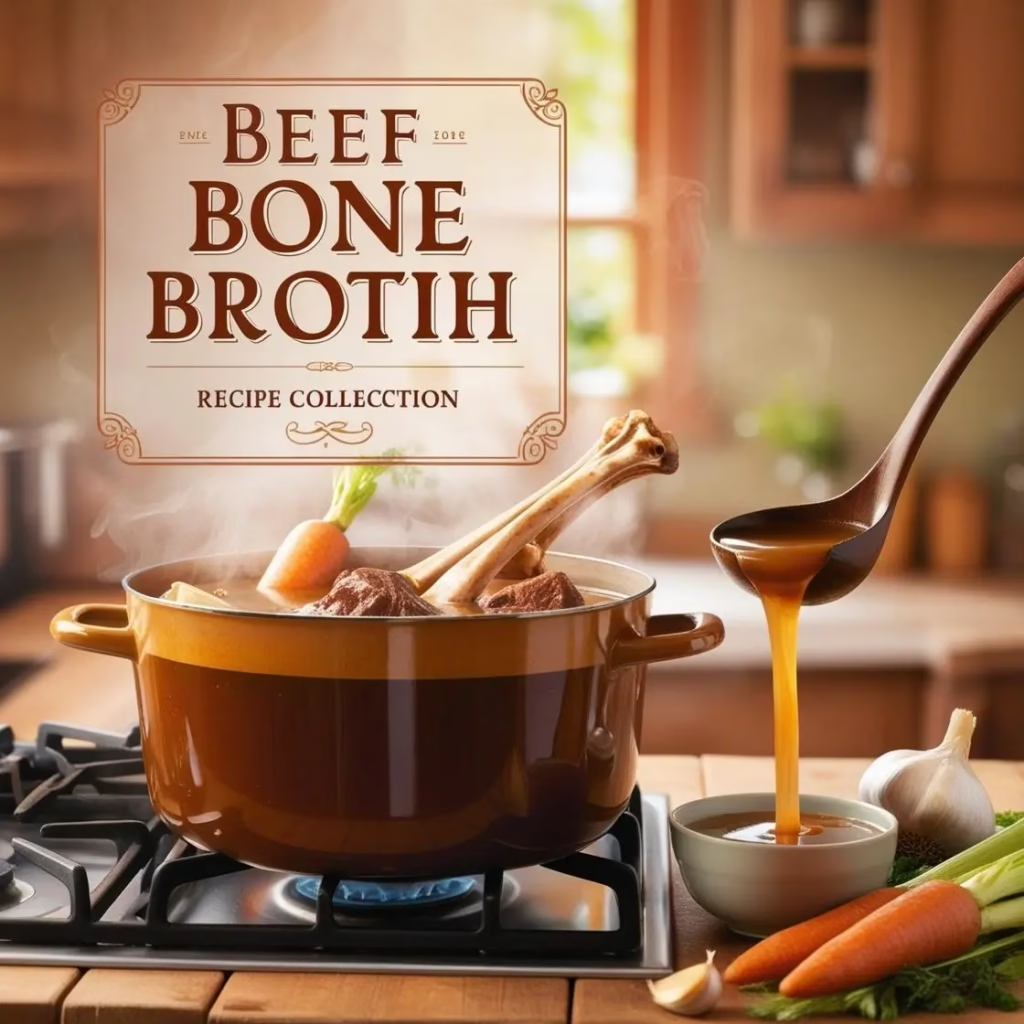
Preparing your own bone broth isn’t just an ancestral culinary tradition; it’s also an economical way to maximize the value of your meat purchases. By using often-neglected parts, you transform what might be thrown away into an incomparable nutritive elixir.
The benefits of regular bone broth consumption are numerous and well-documented. The collagen and gelatin it contains support joint health and can help reduce inflammation. For your digestive system, it’s a true balm: amino acids like glycine and proline promote the repair of the intestinal lining. Not to mention its positive impact on the immune system, particularly valuable during winter months.
The beauty of this recipe lies in its simplicity. Whether you choose the slow cooker (my preferred option for its practicality) or traditional stovetop cooking, you’ll get remarkable results with minimal effort.
Essential Ingredients for Your Beef Bone Broth
The quality of your broth depends directly on the quality of your ingredients. Here’s what you’ll need:
For the bones (about 2 kg/4.5 lbs):
- The key to success lies in diversity. For a truly rich and nutritious broth, let’s combine several types of bones:
- Beef shank bones: These treasures are packed with collagen that will give your broth that sought-after gelatinous texture.
- Marrow bones: The source of intense flavor and essential nutrients. They transform a simple broth into a genuine « bone marrow broth » with remarkable properties.
- Chuck bones: An excellent compromise offering some meat, collagen, and marrow in ideal quantity.
- Neck bones or oxtail: Rich in connective tissue, they’re perfect for extracting maximum collagen.
Favor bones from pasture-raised, grass-fed animals. The difference in taste and nutritional quality is notable.
For vegetables and aromatics:
- 2 medium onions, quartered with skin on (the skin adds nice color)
- 3-4 carrots, roughly chopped
- 3 celery stalks
- 6 garlic cloves, lightly crushed
- 1 bouquet garni (thyme, parsley, rosemary)
- 1 piece of fresh ginger (3 cm/1.2 inch), sliced
- 2 bay leaves
- 1 piece of fresh turmeric (2 cm/0.8 inch), sliced
- 1 tablespoon whole black peppercorns
- 2 tablespoons apple cider vinegar (essential for extracting minerals from the bones)
- Filtered water (enough to cover all ingredients)
The often-neglected but crucial element is apple cider vinegar. Its gentle acidity helps extract precious minerals from the bones, notably calcium, magnesium, and potassium.
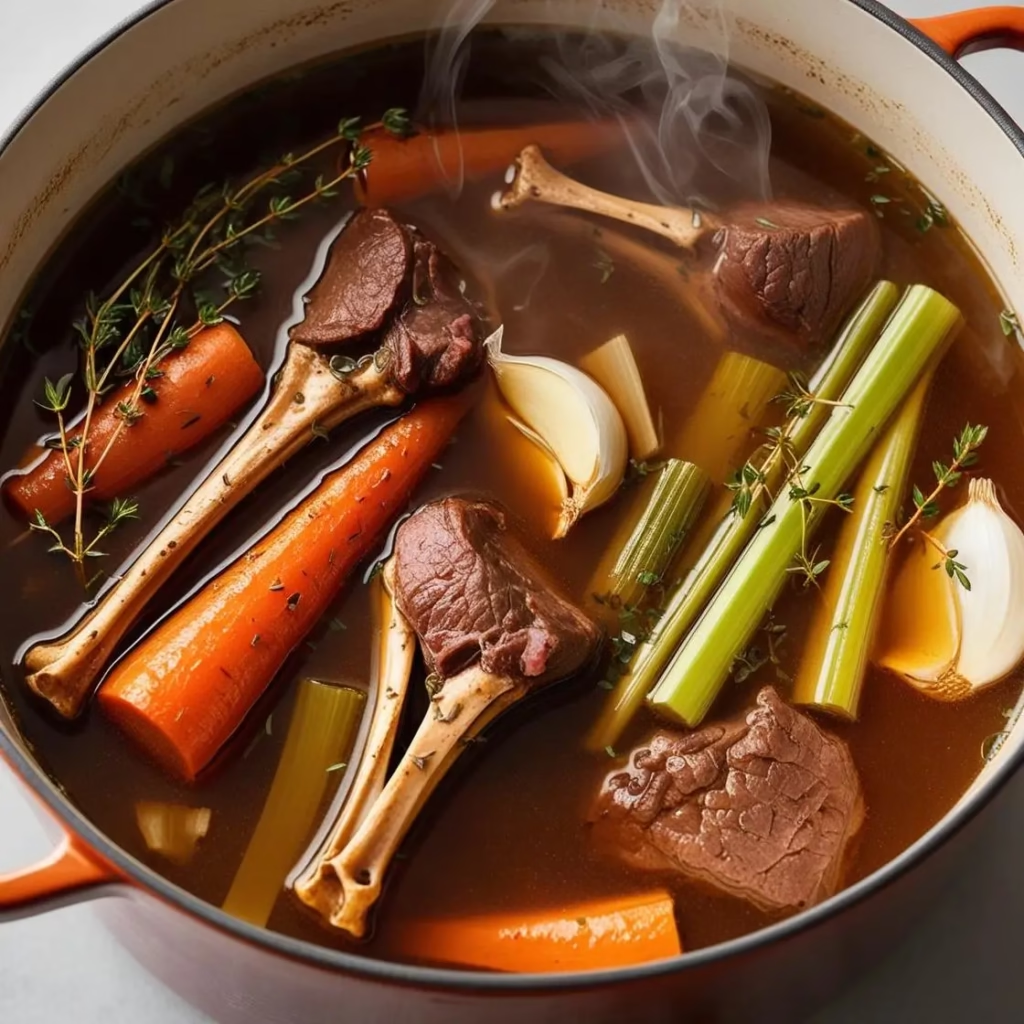
How to Make Homemade Beef Bone Broth Step by Step
Preparing the bones (optional but recommended step)
Start by preheating your oven to 400°F (200°C). Arrange the bones on a baking sheet and roast for 25-30 minutes until they’re well browned. This roasting step develops complex flavors that will give your broth incomparable depth. Feel free to add the halved onions during the last 15 minutes for even more flavor.
1) Combining ingredients
Transfer the roasted bones to your pot or slow cooker. Add all the prepared vegetables, herbs, spices, and apple cider vinegar. This aromatic base will be the signature of your broth.
2) Adding water
Pour enough filtered water to completely cover the bones and vegetables, leaving about 1 inch of space at the top of your container. For a standard slow cooker, plan for about 3-4 quarts of water.
3) Cooking on the stovetop
If you opt for the traditional method, first bring to a boil, then immediately reduce to very low heat. A barely perceptible simmer is ideal. Let simmer covered for at least 12 hours for small bones, and up to 24 hours for large bones like shanks or marrow bones.
During the first two hours, regularly skim the foam that forms on the surface. This scum contains impurities that could cloud your broth.
4) Cooking in the slow cooker
For the method I personally prefer, set your slow cooker to « low » after adding all ingredients. Let cook for 18 to 24 hours. The beauty of this method lies in its simplicity: no need for constant monitoring; your broth simmers peacefully while you go about your day.
After the first two hours, briefly open to skim if necessary, then seal tightly. Avoid opening the lid frequently, as each opening loses heat and steam, thus extending cooking time.
5) Straining the broth
Once cooking is complete, carefully strain your broth. I first use a coarse strainer to remove large pieces, then a cheesecloth or coffee filter for a perfectly clear liquid. You can reserve the bone marrow to spread on toast—a delicacy!
6) Cooling and storing your broth
Let the broth cool at room temperature for maximum one hour, then transfer to the refrigerator. Once cooled, you’ll notice a solidified layer of fat on the surface—this is beef tallow. You can either remove it and store it separately for cooking, or leave it on the broth as natural protection.
For storage, your broth will keep for about 5 days in the refrigerator. For longer storage, freeze it in airtight containers or ice cube trays for easy-to-use individual portions.
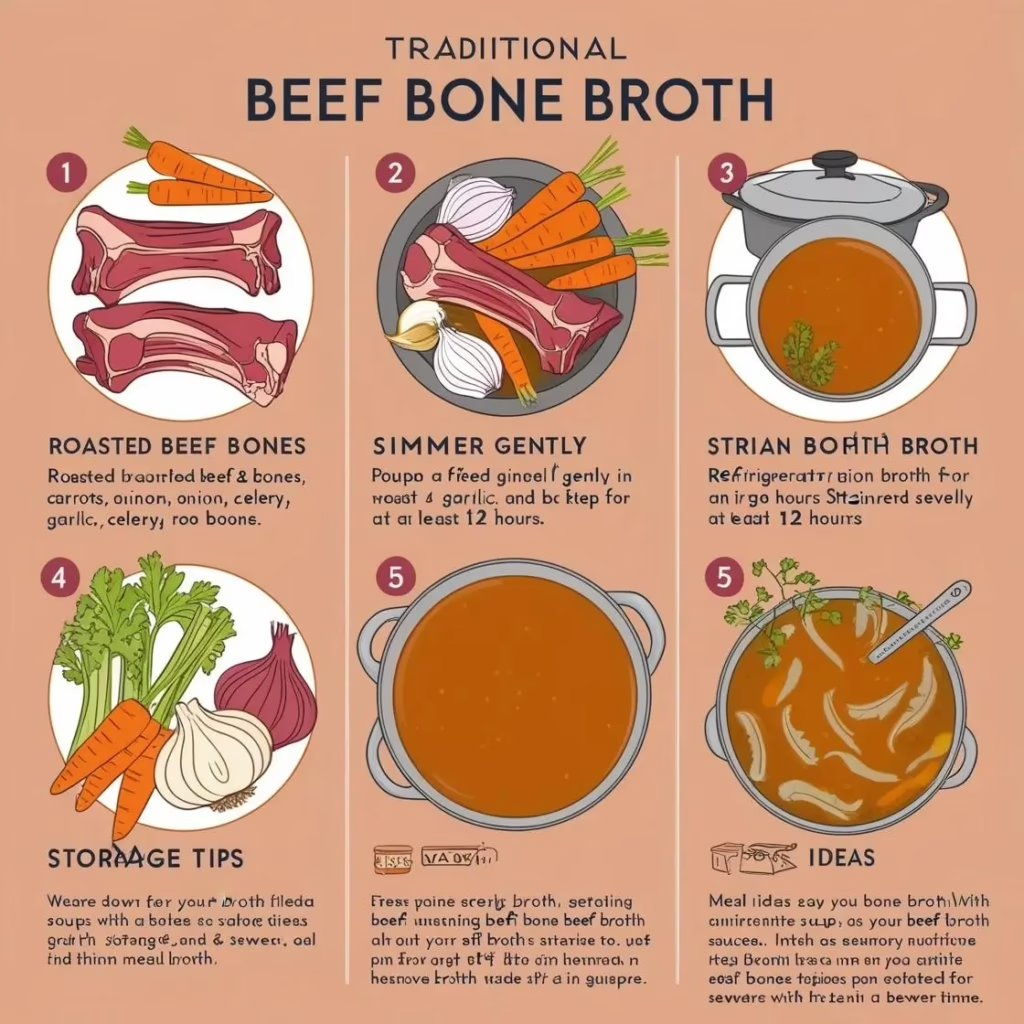
How Long Should You Cook Beef Bone Broth in a Slow Cooker?
Cooking time is a crucial element for an exceptional broth. After numerous tests, I’ve found that a period of 18 to 24 hours gives the best results. It’s only after this prolonged time that the bones fully release their collagen, minerals, and amino acids.
If you’re in a hurry, 12 hours minimum can suffice for a light broth, but you’ll miss some of the nutritional benefits of complete extraction. Personally, I usually set my timer for 20 hours—an ideal compromise between nutritional richness and practicality.
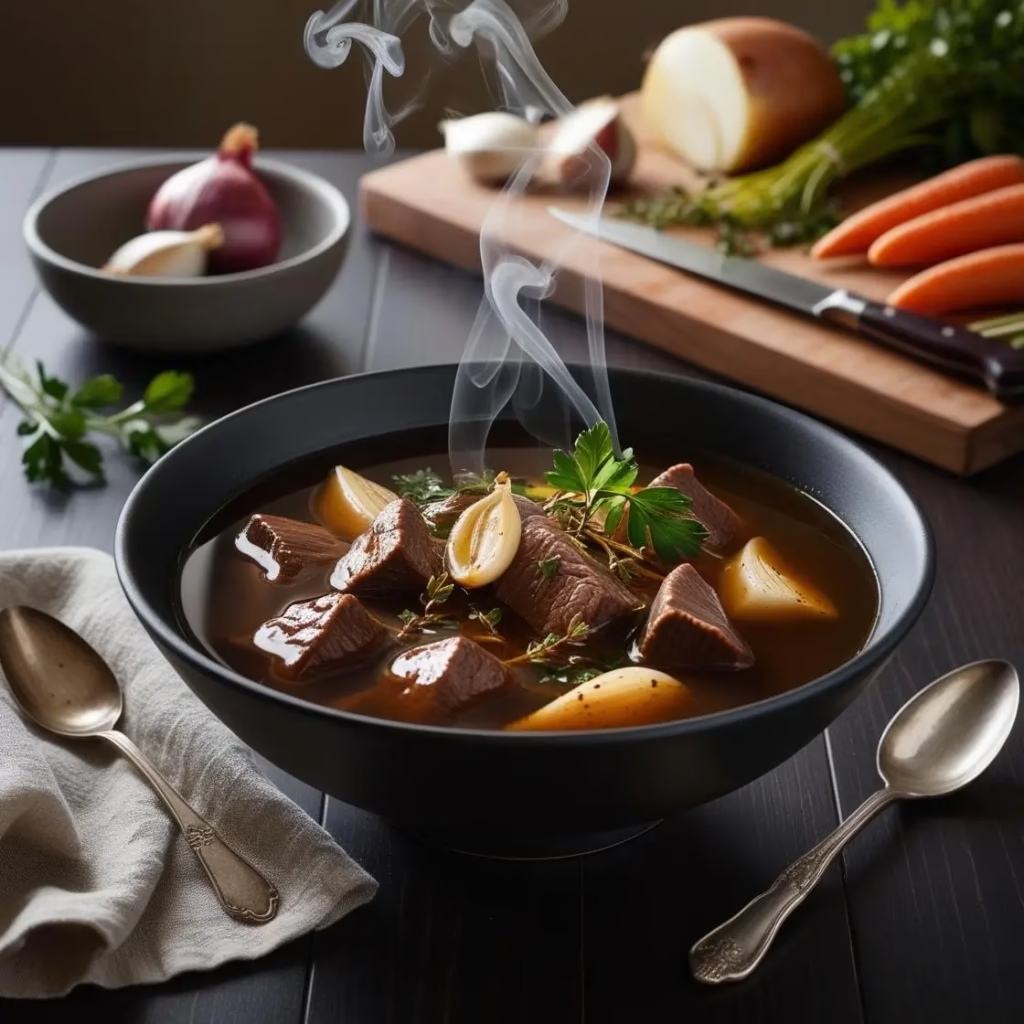
Frequently Asked Questions About Homemade Beef Bone Broth
How to drink bone broth in the morning?
A hot cup of bone broth upon waking is a ritual I’ve adopted for years. Warm it gently, add a pinch of sea salt and some fresh herbs if you like. Some enjoy adding a teaspoon of coconut oil or a squeeze of lemon juice for a touch of freshness.
Is it safe to drink beef bone broth every day?
Absolutely! A daily cup (about 8 oz) is perfectly healthy for most people. Those with sodium restrictions should simply limit adding salt.
How to use beef tallow?
This precious byproduct is excellent for high-temperature cooking. It brings a rich flavor to roasted potatoes and other vegetables. Some even use it as a natural skin moisturizer or to make artisanal candles.
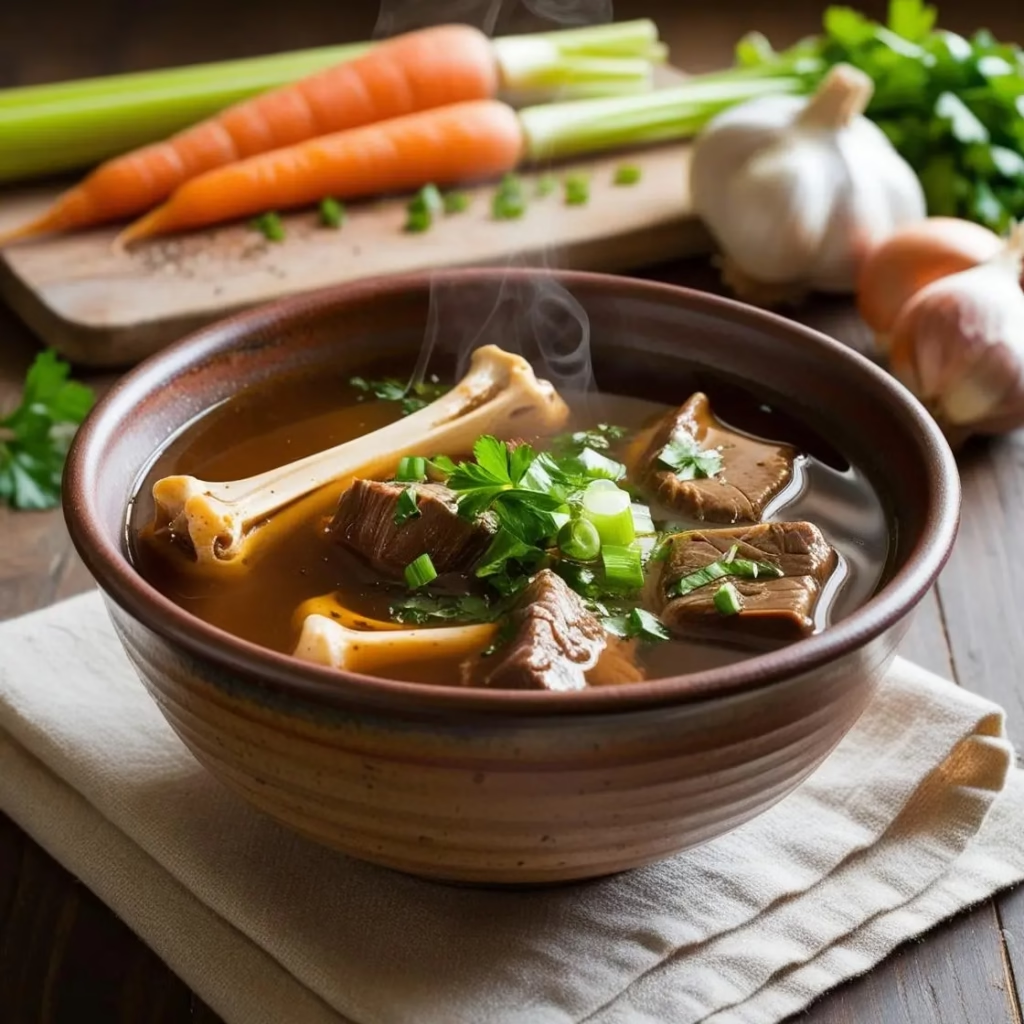
Ideas for Using Your Homemade Beef Bone Broth
Your broth is much more than a comforting drink:
- Enjoy it as is, lightly salted and peppered
- Use it as a base for incomparable soups and stews
- Cook your grains in it rather than water for amplified flavor and nutrition
- Incorporate it into your sauces and meat gravies for more depth (Beef Tips)
- Add a small amount to your morning smoothies (the taste is masked by fruits)
- For the more adventurous, replace part of the water with broth in your hot chocolate for surprising richness
- Use it as braising liquid to tenderize the toughest meats
Nutritional Values (estimate per 8 oz/250 ml serving)
- Calories: 85-120 kcal
- Protein: 7-10 g
- Fat: 5-8 g
- Carbohydrates: 2-3 g
- Collagen: approximately 10 g
- Rich in minerals: calcium, magnesium, phosphorus, potassium
- Source of amino acids: glycine, proline, glutamine

In conclusion, Preparing your own beef bone broth is a return to traditional cooking roots, an act that nourishes both body and soul. This simple yet powerful recipe allows you to create a therapeutic food that our ancestors considered a pillar of health.
I hope you’ll embark on the adventure of this homemade bone broth which, I’m convinced, will become a staple in your kitchen. Don’t hesitate to share your experiences in the comments or explore our other nourishing recipes that celebrate the culinary wisdom of our forebears.
Have you already prepared homemade bone broth? What are your personal tricks? I’d love to read your feedback and suggestions!

The Best Beef Bone Broth (Slow Cooker and Stovetop Methods)
Description
This rich, gelatinous beef bone broth is simmered for 18-24 hours to extract maximum nutrients, collagen, and flavor from a variety of beef bones. The addition of apple cider vinegar helps release minerals, while aromatic vegetables and herbs create a deeply flavored broth perfect for sipping or using as a base for soups and sauces. Make it in your slow cooker or on the stovetop for a nutritious addition to your weekly routine.
Ingredients
Instructions
- Préchauffez le four à 200°C et torréfiez les os pendant 25-30 minutes.
- Transférez les os dans votre mijoteuse ou grande marmite.
- Ajoutez tous les légumes, herbes, épices et le vinaigre.
- Couvrez d’eau filtrée en laissant 2-3 cm d’espace.
- Pour la mijoteuse : cuisez à basse température pendant 18-24 heures.
- Pour la plaque de cuisson : portez à ébullition puis réduisez immédiatement à frémissement très doux pour 18-24 heures.
- Écumez la surface pendant les deux premières heures.
- Filtrez soigneusement le bouillon terminé.
- Laissez refroidir puis réfrigérez ou congelez.
Notes
- The broth should gel when refrigerated – this indicates a high collagen content
For drinking, season with sea salt to taste before consuming
Use grass-fed beef bones when possible for optimal nutrition
Save the bone marrow to spread on toast or add to other dishes

